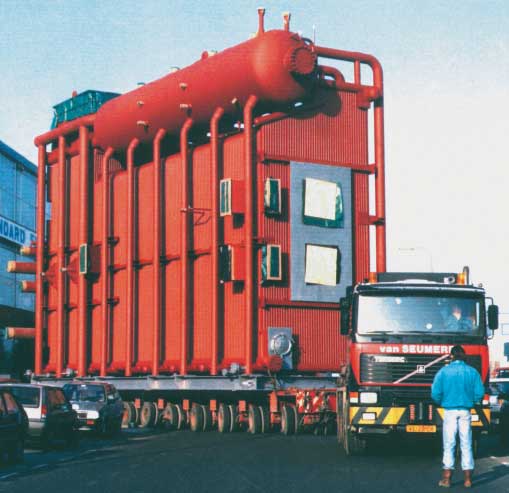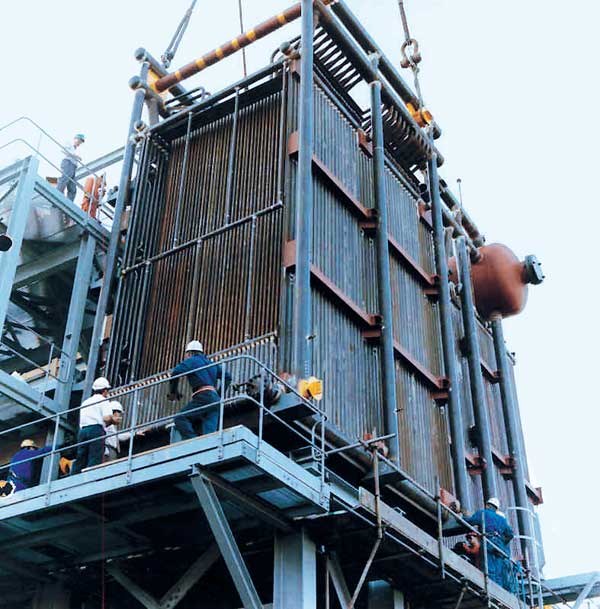The La Mont boiler is an ideal waste heat boiler and also suitable for applications
requiring a special boiler design, e.g. due to lack of space. Therefore,
local conditions are almost irrelevant as water circulation can be easily
realised also at angled tube arrangements due to the circulation pump.

Examples for La Mont boilers are:
- Waste heat steam boilers at processes with hot gases and dust content,
- Waste heat steam boilers behind fluidized bed combustion,
- Waste heat system in nitric acid and caprolactam hydroxylamine plants,
- Waste heat steam boiler in roasting processes,
- Waste heat systems in sulphuric acid plants.
Potential fuels are:
- Oil,
- Gas,
- Coal,
- Biomass,
- Waste,
- Waste heat.

Advantages of the La Mont system compared to natural circulation system
Water circulation runs before heating starts. Inevitably, water is distributed on all tubes according to heat absorption of each single tube. Even at very high specific heat load of single locations there is no danger of a local tube overheating, as mass flow is adjusted to that high load.
Material Stress of the Heated Tubes
The possibility to use tubes with smaller diameter leads to thinner tube wall thickness and therewith to decreased material stress of the tubes due to the difference between tube outer and inner temperature. Forced circulation provides an even temperature in all tubes at start-up yet.
Steam and Water Separation
Water circulation ratio is limited to a factor 2 to 5. Thereby, separation of steam and water in the drum will be eased. As a consequence the drum can be smaller at constant steam quality.
Quick Start-Up from Cold Condition
Start-up can be carried out with high combustion capacity as a water circulation in the tubes already exists before start-up. At waste heat boilers the tubes can be loaded with the full heat amount immediately. For the actual boiler the start-up velocity is only given by the valid temperature gradient in the drum wall, which depends on the wall thickness. The drum diameter at a La Mont boiler can be smaller than at a natural circulation boiler. So the wall thickness can be smaller, which leads to advantages at start-up. At start-up superheater and pre-heater can be cooled with forced circulation by a corresponding circuit.
Fast load changes
Load changes from small to large can be carried out very quickly as mass flow in the tubes already exists at small load. At natural circulation boilers mass flow has to speed up at heating. At start-up from cold condition and at load increase a part of the water is displaced from the heating surfaces into the drum by steam bubbles. A La Mont boiler has a smaller amount of water compared to a natural circulation system as on the one hand circulation number is smaller and on the other hand heating surfaces contains less water due to smaller tube diameter.
Pressure Decrease
The valid pressure decrease velocity depends on the water velocity in the downcomers. At a natural circulation boiler this velocity is limited by the frictional resistance, which again is given by the natural buoyancy height, i.e. the boiler height. At a La Mont boiler the water velocity in the downcomers can be optimised by choosing the net pressure of the circulation pump.
Design Freedom
All these reasons prove that a La Mont boiler is an ideal waste heat boiler: Tube arrangement can be adapted to the site condition without limitation. Even at very high heating very long horizontal tube arrangements are possible. Utilization of remaining heat from chemical or metallurgical processes is possible without danger for the heating surfaces even with highest temperatures. Additionally, utilization of remaining heat from processes with relative low temperatures, but very high fuel gas amount, where large draught cross section is required is possible. Despite this high fuel gas amount the boiler can be adapted to the existing site condition.
Usually, for forced distribution of the water also the single tube banks are provided with La Mont nozzles. Exact water circulation calculations show if nozzles are necessary.
Once-through water tube boiler
Demand for higher efficiency and enlargement of energy demand led to higher pressure, temperature and performance. This demand affects steam generator types and design. At natural circulation pressure above ca. 180 bar lead to the presented complications. However, already in the 1930ies the development of once-through system was encouraged, because big drums and downcomers are not necessary in that system. Additionally, a larger combustion chamber (for difficult coal types) can be design due to higher design freedom compared to natural circulation systems. It was also recognized that owing to a more flexible reaction on heat input a more frequent start-up and shut-down is not a problem. Obviously, the once-through system, where feed water is pre-heated, evaporated and superheated in one step, allows to apply the highest yet controllable pressure and temperature. Supercritical pressure of 400 bar, superheater temperature of almost 700 °C at capacity of over 2000 t/h steam and thermal efficiency of 43 % in condensation power plant are in realm of possibility.

Water circulation runs before heating starts. Inevitably, water is distributed on all tubes according to heat absorption of each single tube. Even at very high specific heat load of single locations there is no danger of a local tube overheating, as mass flow is adjusted to that high load.
Material Stress of the Heated Tubes
The possibility to use tubes with smaller diameter leads to thinner tube wall thickness and therewith to decreased material stress of the tubes due to the difference between tube outer and inner temperature. Forced circulation provides an even temperature in all tubes at start-up yet.
Steam and Water Separation
Water circulation ratio is limited to a factor 2 to 5. Thereby, separation of steam and water in the drum will be eased. As a consequence the drum can be smaller at constant steam quality.
Quick Start-Up from Cold Condition
Start-up can be carried out with high combustion capacity as a water circulation in the tubes already exists before start-up. At waste heat boilers the tubes can be loaded with the full heat amount immediately. For the actual boiler the start-up velocity is only given by the valid temperature gradient in the drum wall, which depends on the wall thickness. The drum diameter at a La Mont boiler can be smaller than at a natural circulation boiler. So the wall thickness can be smaller, which leads to advantages at start-up. At start-up superheater and pre-heater can be cooled with forced circulation by a corresponding circuit.
Fast load changes
Load changes from small to large can be carried out very quickly as mass flow in the tubes already exists at small load. At natural circulation boilers mass flow has to speed up at heating. At start-up from cold condition and at load increase a part of the water is displaced from the heating surfaces into the drum by steam bubbles. A La Mont boiler has a smaller amount of water compared to a natural circulation system as on the one hand circulation number is smaller and on the other hand heating surfaces contains less water due to smaller tube diameter.
Pressure Decrease
The valid pressure decrease velocity depends on the water velocity in the downcomers. At a natural circulation boiler this velocity is limited by the frictional resistance, which again is given by the natural buoyancy height, i.e. the boiler height. At a La Mont boiler the water velocity in the downcomers can be optimised by choosing the net pressure of the circulation pump.
Design Freedom
All these reasons prove that a La Mont boiler is an ideal waste heat boiler: Tube arrangement can be adapted to the site condition without limitation. Even at very high heating very long horizontal tube arrangements are possible. Utilization of remaining heat from chemical or metallurgical processes is possible without danger for the heating surfaces even with highest temperatures. Additionally, utilization of remaining heat from processes with relative low temperatures, but very high fuel gas amount, where large draught cross section is required is possible. Despite this high fuel gas amount the boiler can be adapted to the existing site condition.
Usually, for forced distribution of the water also the single tube banks are provided with La Mont nozzles. Exact water circulation calculations show if nozzles are necessary.
Once-through water tube boiler
Demand for higher efficiency and enlargement of energy demand led to higher pressure, temperature and performance. This demand affects steam generator types and design. At natural circulation pressure above ca. 180 bar lead to the presented complications. However, already in the 1930ies the development of once-through system was encouraged, because big drums and downcomers are not necessary in that system. Additionally, a larger combustion chamber (for difficult coal types) can be design due to higher design freedom compared to natural circulation systems. It was also recognized that owing to a more flexible reaction on heat input a more frequent start-up and shut-down is not a problem. Obviously, the once-through system, where feed water is pre-heated, evaporated and superheated in one step, allows to apply the highest yet controllable pressure and temperature. Supercritical pressure of 400 bar, superheater temperature of almost 700 °C at capacity of over 2000 t/h steam and thermal efficiency of 43 % in condensation power plant are in realm of possibility.

